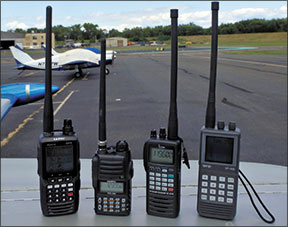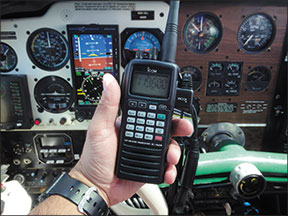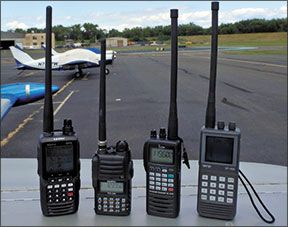Back in the day, King’s KX99 handheld transceiver ruled the roost. It was a big, heavy and solid performer. Today, portable transceivers are far more advanced, but their purpose hasn’t changed.

In lesser aircraft without electrical systems, a portable might be the only option for communicating. Portable transceivers can also bring sizable amounts of utility to your mission, especially when used to fetch clearances, listen to the ATIS before engine start and talking (and navigating, God forbid) your way down during primary radio failure.
Search the transceiver section of the Sporty’s catalog and it’s easy to be overwhelmed by what appears to be a wide variety of models. But we found that many are defeatured versions of a flagship model.
We gathered a variety of them to see which offers the best mix of rugged fit and finish, good battery endurance and a logical user interface and settled on four favorites.
Sporty’s sp-400
When we looked at these things a few years ago, the $349 SP-400 that’s built by an independent Japanese company and branded by Sporty’s Pilot Shop stood out as an all-around solid performer and good value. We liked it so much, we bought one to use as a primary radio in a Piper Cub. This created the basis for a long-term evaluation that had the SP-400 back to Sporty’s twice for repair. One was an issue with the AA Alkaline battery pack (a rechargeable pack is optional) and the other was a failure of the set’s audio output jack. Thanks to Sporty’s exceptional customer service and a five-year warranty, both repairs were accomplished at no charge and downtime was minimal.

While we found it to be a good performer in previous evaluations, Sporty’s dropped the oversized and bare-bones SP-200 model. Along with a variety of models from ICOM and Yaesu, the company primarily sells the SP-400. Measuring 6.54 inches tall, 2.35 inches wide and 1.46 inches deep, the radio is one of the larger ones on the market.
But among other models, we think the SP-400 is the easiest to use. It has basic controls that are placed where you might expect them to be, including a dedicated volume (which also serves as a power control) and squelch rotary knob placed on the top of the case.
Compared to earlier versions, the latest SP-400 has an improved LCD display that’s easier to read in direct sunlight and has a dedicated night mode for use in the dark, plus user-adjustable contrast and backlighting control.
The SP-400 doesn’t have a lot of features, but it does have localizer and glideslope with adjustable OBS, storage for 20 memory channels, plus NOAA weather radio band.
The benefit of not having a lot of features is the ability to use the radio without having to reference the user’s guide—an edge we give the SP-400 over most of the other radios we evaluated. That could pay big in an emergency situation.
But unlike the others, the SP-400 doesn’t come standard with a headset adapter. That’s a $26 option. When used with the adapter, the radio provides transmit sidetone, which is the sound of your voice during modulation. When used as a primary radio, that’s imperative, in our view.
Icom
ICOM’s line of aviation portables has been the same for as long as we can remember. As a result, the radios lack some of the gee-whiz appeal found on the more modern Yaesu models. But ICOM makes up for it with a durable build quality and a utilitarian feature set. That’s why the ICOM A24 has remained an accessory in our own flight bag for years.
The A24 is the flagship model and has VHF comm and nav functionality (the A16 is an identical unit less navigational functions). ICOM brags of the unit’s single-handed operation for use while flying and it fits the task, in our view. With battery pack, it stands roughly 5 inches tall, making it efficient for storing in a map pocket. At 2 inches wide, 1 inches thick and weighing roughly 15 ounces, we find the radio comfortable to use in the cockpit, even when using the headset adapter. We still wish the radio had a one-shot squelch adjustment. For instance, the squelch is adjusted by pressing a dedicated squelch key and then setting the threshold with the right rotary knob.
Until you become familiar with the operation, you’ll likely grab the more prominent rotary knob at the top of the case to adjust the volume, but this knob changes the frequency (a feature we prefer rather than keying it in from the keypad.) But even so, we find this knob is annoyingly close to the flexible antenna.
If you ever had the need to use it, the nav feature is easy to use and offers both To/From navigation and the current radial. It also shows a CDI. We like the NOAA weather radio alert function when plugged into a wall outlet and the weather function can also be used when on the air-band. There’s a 200-channel memory bank for frequency storage, which might be overkill. The only frequencies we store in our unit is the local ATIS, ground control and departure frequency.
All of the ICOM units have a good display with characters that are easy to read in all lighting conditions. The unit has a 1650 mAh NiH battery with excellent endurance. An alkaline battery pack is optional and you’ll want it for use as an emergency radio, unless you can always remember to keep the rechargeable topped off. We can’t.
On the topic of batteries, we don’t like that the unit doesn’t indicate when it’s charging. In other words, the other units in the group verify the battery is being charged with simple red and green LEDs. Not the ICOM. You have to guess that it’s fully up to charge—or that it’s charging at all when it’s plugged in.
ICOM’s A14 is a communications-only portable with a special 700mW loudspeaker using a BTL amplifier (essentially dual amplifiers that drive both ends of a speaker load). Translation: Loud. So loud, in fact, that we used the A14 while standing next to a Citation that was spooled at ground idle and were able to hear the tuned ATIS broadcast. We think the A14 is a good option for ground support or for emergency use without a headset.
Yaesu
Yaesu is a familiar name in the amateur and marine radio market. The company’s Vertex Standard line of land mobile equipment (which included airband transceivers) was taken over by Motorola during a division merge. Yaesu continues to manufacture the aviation radios, but dropped the Vertex name.
When we evaluated the Yaesu/Vertex line in 2010, we dinged the radios for having nonstandard SMA antenna connections, since most connections to external antenna systems will have BNC connectors. Yaesu apparently listened because all of its aviation radios now utilize BNC antenna connections.
Yaesu’s flagship aviation portable, the FTA-750L Spirit, is the only portable on the market that has a built-in WAAS GPS. The problem is the GPS doesn’t have the functionality most pilots would expect, including a database of airports and navaids. Instead, it’s up to the user to either manually enter or download the lat/long coordinates of the waypoints with Yaesu’s PC programming software.
Yaesu packs a lot of features into the Spirit 750’s reasonably small 5.2 by 2.4 by 1.3-inch chassis.
The 1.7 x 1.7-inch dot matrix, backlit LCD display is a mediocre performer in bright sunlight, although manually boosting the contrast helps.
Despite having a feature set that’s busy for a portable radio, we found the Spirit 750 easy to get along with thanks to a straightforward menu structure. A dedicated Menu key and bezel-mounted arrow keys (or the inner rotary knob) move you around the menu structure, while an Enter key selects the function. And there are plenty of functions.
Adjusting the frequency is accomplished with the outer knob on the top of the radio (or by direct keypad entry), while volume is adjusted with the inner knob—something we like. It’s just natural having a dedicated rotary knob for volume and it’s missing on the lesser Yaesu FTA-230. What is missing on the FTA-750 is a one-shot squelch control. Instead, press the squelch button on the side of the radio (below the transmit button) and then rotate the knob to set squelch threshold. The squelch settings are linear, but we wish it had a dedicated squelch knob.
There’s plenty of frequency storage capability—up to 200 channels—which are accessed from the Memory Book icon from the unit’s onscreen menu. The menu screen also gains access to a countdown timer, NOAA weather channels, a setup menu for adjusting the display and accessing what’s called the Split Mode, which allows you to transmit a call to a flight service station while receiving on the VHF navigation band. The display automatically shows the CDI, based on the signal it’s receiving, including localizer and glideslope. There’s also a compass rose and a SOG (speed over ground) function, based on the unit’s internal WAAS GPS receiver—a helpful feature, in our view, for use in emergency situations. But again, we had hoped for a more useful GPS navigator.
There’s also a Dual Watch mode that automatically checks for activity on a preset priority channel. For example, if an approach frequency is set to priority Dual Watch will monitor it for 200 millisecond intervals while you operate on another frequency. The FTA550 is a defeatured version without GPS receiver and is $100 less.
We’re fond of the Yaesu FTA-230 radio because of its compact footprint. At 4.09 inches high, 2.36 inches wide and 1.2 inches deep, it’s easy to slide into a shirt or pants pocket and even easier to lose in a flight bag. Thanks to its outstanding rechargeable battery life, we found it in a backpack when it received a transmission from an overflying airliner one night. It was powered on for much longer than the advertised 8-10 hours of endurance.
The FTA-230 is submersible (3.3 feet for 30 minutes), making it a good fit for water ops. The keypad and LCD display uses Yaesu’s effective Omni-Glow orange backlighting, although the unit’s small stature could make the keys challenging for fat fingers. Volume is controlled with dedicated up and down arrow keys on the keypad and we would prefer a rotary knob.
The FTA230 has a VHF nav band receiver but not CDI, NOAA weather band and accommodates 150 channels in memory.
Top picks
Our thanks to Gulf Coast Avionics in Lakeland, Florida, for graciously providing some of the radios and guidance for our evaluation.
Based on simplicity alone, we think the Sporty’s SP-400 stands out as the winner and is worthy for use as a primary radio. But when it comes to long-term durability and reliability, the ICOM A24 navcomm and comm-only A14 are proven, if you can live without advanced features.
While the GPS-equipped $400 Yaesu FTA-750 is loaded with more functions than any other radio on the market, a GPS waypoint database and navigation function would give it more real-world utility. We do, however, like the GPS ground track that can be useful in an emergency.
If a compact size is a major consideration, we think the Yaesu FTA-230 is the clear winner, but it has a quirky feature set. On the other hand, it has a good display, excellent battery life, is priced right and its comm transmitter performed we’ll on the bench.
Last, consider installing an external antenna. The few hundred dollars it might cost could pay off when you need to transmit more than a few miles away.
BENCH RESULTS: HOT LITTLE RECEIVERS
To get a sense of how each radio compares in terms of comm and nav receiver performance, we put them on the avionics test bench at VIP Avionics in Hartford, Connecticut. Don Boccaccio, VIP’s bench genius, looked hard at comm transmit power, receiver sensitivity and modulation quality, in addition to nav receiver performance. As Boccaccio put it, “These are hot little receivers.”
Each radio transmitted at least 1.0 watt of power, although the ICOM A24 had the most, at around 1.5 watts. It’s important to stress this isn’t nearly enough power to transmit any sizable distance while using a portable antenna. Realistically, you’ll need an external antenna. The transmitter modulation quality, measured with a calibrated spectrum analyzer, was about equal among the radios, except on the Yaesu Spirit 750L where it was notably worse. But when it came to nav receiver performance, the Yaesu 750L blew the others away. Injecting a raw nav signal directly into its receiver, it received the VOR down to 0.5 microvolts and the glideslope at 0.63 microvolts of signal. The others stopped receiving at around 1.3 microvolts, on average. The lesser the number, the greater the distance the receiver will receive.
Still, we think comm performance and ease of use is more critical than nav performance. In these areas, the ICOM and Sporty’s shine. But if we had to fly a glideslope using a portable radio as primary (which is awkward, at best), we would want to do it with a Yaesu 750L, based on the results of a critical bench evaluation.





